|
A glimpse into the past...
donations have
been given at times. Tray favors have been made for the residents at
Maplewood Manor for some special occasions and Christmas caroling has
been enjoyed a few years.
In 1971 a member
of our club was selected a District Entomology winner. Cheryl Walter
won a trip to the National 4-H Congress in Chicago. The current
membership is 11 with Melody Northup serving as President. Clothing is
the main project of 1973 and promises to be an interesting year.
CAMPFIRE
GIRLS
January 29, 1914.
The Campfire Girls held their council and initiated a new member. The
Campfire Girls is a new group, having been established here early in
the summer of 1913.
September 9,
1920. Fifteen of Keota's young misses have organized a Keota camp of
Campfire Girls with Mrs. Lola Gilbert as Guardian. The Fire Tatapochon
Camp or "can't be pulled apart" camp, is the name of the local post.
Dorothy White was appointed President; Mildred Ochs, Sec'y; Marion
Morris, Treas. They also appointed program, entertainment, hike and
cheer committees.
February 2, 1922.
CAMPFIRE GIRLS. The Campfire Girls are going in for a bit of
philanthropy and will put a brick fire place in the city park. They
expect it to cost from $100 to $150.
March 9, 1922.
CAMPFIRE GIRLS. The Campfire girls organization received a letter from
National Campfire headquarters stating that the first award in Class C,
an honorary medal, has been awarded to the Keota organization on their
report for their years work. This is the only award that has come to
the state of Iowa, all others have gone to large organizations in the
east, except one in Minneapolis and one in Illinois.
November 2, 1922.
CAMPFIRE GIRLS. The Community Fireplace, erected and paid for by
Campfire Girls under guidance of Mrs. L. Gilbert, was presented to the
community last Friday evening in the park. There was a program with
singing and short talks. Mayor Gilbert accepted the Fireplace and
tables for the community. Lunch was served. The girls are grateful to a
number of business firms that donated some materials used.
May 17, 1923. The
Campfire Girls of Keota receive honorable mention for the second year.
It is the highest honor a chapter of this organization can win.
July 19, 1923.
The Campfire Girls have had the City Park wired and it is now lighted
every night when the weather is fair. The girls pay the bill.
September 27,
1923. Mrs. Lola Gilbert is working up a junior organization for
Campfire Girls. The newer group will be girls 11 to 13.
August 6, 1925.
The Campfire girls are going to build a bungalow at Anderson Park on
the Des Moines river near Keosauqua. They plan to spend at the most
$400. It will be 22 x 28 with screened porch across the front, living
room, kitchen, dressing room and large attic. The bungalow was
completed and dedicated September 1, 1925. The girls and their
Guardian, Mrs. Gilbert, Mr. Gilbert, Rev. and Mrs. Rayhill and some of
the parents drove to Keosauqua for the day.
December 31,
1931. The Tetapochin Campfire Girls held their annual reunion at the
home of their guardian and friend. Although a number of the girls have
joined the ranks of the matrons, the entire group was present for the
Christmas party. There was a gift exchange and gifts were presented to
Mrs. Gilbert ("Kim") and Mr. Gilbert ("Uncle Edd").
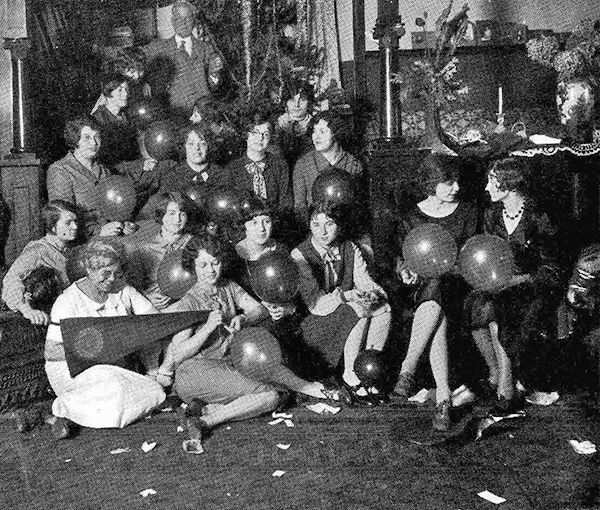
Campfire Girls at the home of Mrs. Lola Gilbert. Standing in back,
Ed. Gilbert. Left to Right,
Hazel Irelan, Elizabeth White, Helen Helscher,
Mary Leinen. Second row from back,
Mildred Ochs, Harriet
Ewing, Eula Chambers, Marjorie Ochs, Third row, Dorothy Morris,
Harriet Morris, Mildred Palmer, Marion Morris, Dorothy White,
Thelma Kirkpatrick.
Sitting on floor, Mrs. Gilbert, Ruth Ranous.
Keota's
Railroad Park
June 1, 1911. A
movement is on foot to park the south side of the Railroad right of way
from the alley east of J. S. Martin's residence (now The Powell Funeral
Home) on west two or three blocks.
December 7, 1911.
Agent Brown received a letter from Railroad Headquarters recently
asking if the people of Keota were willing to pay the stupendous amount
of $1.00 per year for the lease of the land, and half a dozen men have
said they would stand good. This is generous on the part of the Company
and we ought to do our part. That isn't alI — a handsome bandstand will
be built by J. S. Martin and wife, and that isn't all yet — Mr. and
Mrs. Martin will donate all the trees that are needed for the park
besides helping with a cash subscription. Mayor Gilbert and the Council
is interested as well as many others. Let us all pitch in and help make
Keota a delight for travelers who pass through on trains.
Jan. 25, 1912.
Mayor Gilbert received the lease for our railroad park yesterday from
the officials. All that is necessary now is for the town council to
approve it.
April 25, 1912.
J. S. Martin broke ground on the new park last week by setting out 25
or 30 elm trees on plot opposite his residence. The work on the band
stand will start as soon as he can get the men.
171
A glimpse into the past...
SINGMASTER BUFFALO, DEER AND
ELK HELPED MAKE KEOTA FAMOUS
The
Singmaster
buffalo, deer and elk which were one of the famous attractions brought
sight-seers to Keota for many years.
The
animals were
the property of J. O. Singmaster and had the range on a 35-acre field
on Maple Grove farm. The buffalo were descendents of a herd which was
started in 1902 when Mr. Singmaster's father, C. F. Singrnaster,
secured a bull and two cows from the herd in Yellowstone National Park.
The animals were placed in a field at Maplehurst, the Singmaster ranch
a mile and a half northwest of Keota, and they multiplied rapidly.
In
1912 half of
the herd was transferred to the J. O. Singmaster estate. The other half
remained at Maplehurst and became the property of C. A. Singmaster who
was then the owner of the ranch.
The
field in
which J. O. Singmaster's herd was confined was near the road and the
animals attracted many sightseers from far and near. At one time this
herd numbered 50 animals. The field was enclosed by a seven foot fence
of No. Nine woven wire.
For
a number of
year s a herd of elk varying from ten to fifteen head also occupied the
field. Deer always were kept with the buffalo. They were hard to keep
within bounds and occasionally one escaped and strayed away. In this
manner a herd of wild deer became established in the timber along Skunk
River, ten miles south of Keota.
The
buffalo and
deer lived peaceably together, but the buffalo were not to be trusted
where man was concerned. No one ever entered the field on foot. Each
year a buffalo was killed always in the field with a high powered rifle
to furnish meat for the family and friends.
Many
years ago a
fine specimen from the Singmaster herd of buffalo was mounted and
presented to the Iowa State Historical Museum at Des Moines.
In
the late 1920s
(1926-1928) the Pete Carr Rodeo was held at Maplehurst. The cowboys
roped and rode several of the buffalo, which was quite an attraction.

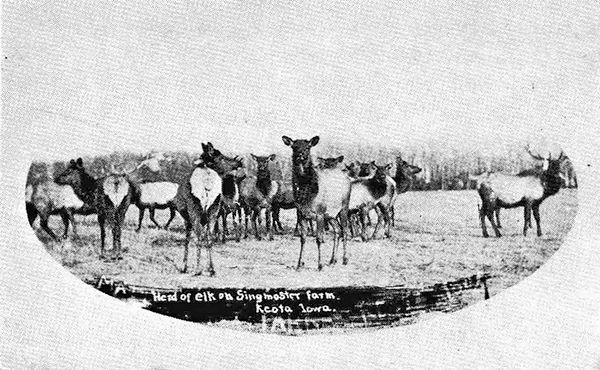
May 11, 1911.
Special agent for Des Moines Register and Leader was in Keota and
visited the Singmaster ranch.
C. F. Singmaster
& Sons are negotiating for sale of buffalo herd to Howard Eaton of
Wolf, Wyo., who, if he buys them, will take the herd out of the
country. It is one of the largest individual herds in the United
States.
A government
inspector who visited the ranch a year ago said the government was so
desirous of preserving the herd that they have offered the services of
a government veterinary in case animals become ill.
Mr. Singmaster
bought the original seven animals from Mr. Eaton seven years ago and
were valued at $450 each at that time. They now have 23 animals valued
at $1000 each.
They are penned
in an 80 acre park and live on grass during its season and corn fodder
through the winter months.
A herd of 16 elk
share the park. The first of this herd was purchased 15 years ago. The
Singmasters are also large importers of horses.
March 15, 1934.
The Singmaster buffalo which were one of the famous attraction bringing
sightseers to Keota for many years were sold by J.O. Singmaster of
Maple Villa. A local buyer was the purchaser, trucking them to Cedar
Rapids as beef to be butchered and marketed for beef prices. There were
11 head. One was butchered here and sold locally. The buffalo herd was
established in 1902 by C.F. Singmaster and at his death was divided
between J.O. and C.A. Singmaster. The former kept up his herd and they
were visible to sightseers along the Keota-Kinross road north of town.
C. A. Singmaster has two of his herd. The original herd was started
from a bull and two cows secured from Yellowstone Park. The elk herd
never flourished and the last one died several years ago. A herd of
deer was also established. The buffalo are gone from our area but an
exceptional fine specimen may be seen in Des Moines in the State
Historical Museum.
172
A glimpse into the past...
MRS.
EDNA SINGMASTER, CENTENARIAN
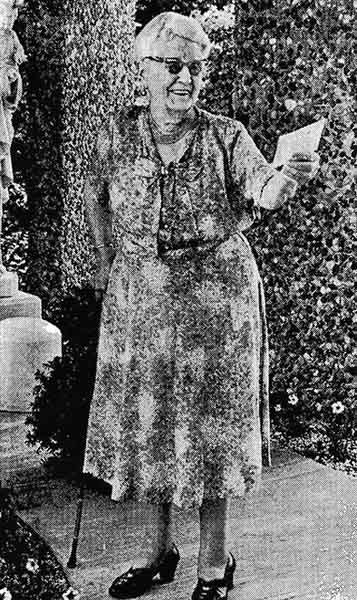
A "happy birthday" card from President Richard Nixon
delights Mrs. Edna Singmaster, a resident of the
Kahl
Home, Davenport. |
He gave me another with five diamonds in it but I
had to give it up after he died."
Her gentle lines, peaches and cream complexioned
face belies her 100 years. There are many memories but through the
century the years begin to fuse. It's difficult to pinpoint when
certain things occurred. And this is unimportant to the woman who lives
as much in the present as she does the happy past.
Edna Singmaster likens her story to that of
Cinderella. "I was brought up a poor girl but a happy one. My husband
was the best man in the world. I waited until I was 27 years old before
we married. And oh what a wonderful life we had!"
That good life revolved around their business of
importing draft horses from Europe. "Our son never had a birthday in
this country until he was 12 years old. We traveled by steamship to
France, England, Scotland and occasionally to Germany."
The horses were brought back to their home in
Keota, Iowa, where they stabled an average of 300 in seven barns.
"I loved horses from the time I was a little girl.
And I always wanted to play the piano but mother said that wouldn't be
possible unless we could strap a piano to the horse's back. Later I
learned dressmaking and had a shop in Keota for several years.
"My husband and I had the world champion Percheron
and I had a team of identical chestnut sorrels that I really loved.
Then, one day my husband came home with a brand new Pierce Arrow and I
cried. Why, I didn't want to hold onto a wooden wheel and it meant I
had to give up my team."
The centenarian couldn't recall the first
president for whom she voted. "My father was a Democrat and my husband
a Republican so I had to be pretty diplomatic during any talks about
politics. I do remember that I wanted to vote for Franklin Roosevelt in
the worst way."
She arrived at the Kahl Home three days before the
new building opened six years ago. It was one of her many friends there
who notified President Nixon of her upcoming birthday.
After her husband's death, Mrs. Singmaster worked
as a housemother at the Annie Wittenmyer Home for a number of years.
This she counts as another facet of her good life.
|
|
July
25, 1969
Today is
Mrs. Edna Singmaster's 100th birthday anniversary. She was the first
one to arrive in the chapel for 7 a.m. Mass as she is every morning at
the Kahl Home.
Earlier in
the week Mrs. Singmaster talked about the fact that certainly she has
no secret for her longevity.
Brown eyes
sparkled beneath her neatly coiffed, white hair. Slender hands fingered
an antique gold bracelet as she spoke. "This was the first birthday
present from my husband.
|
173
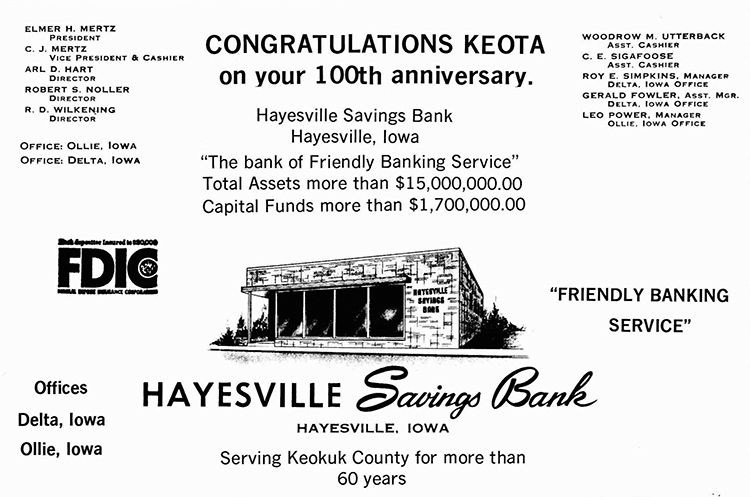
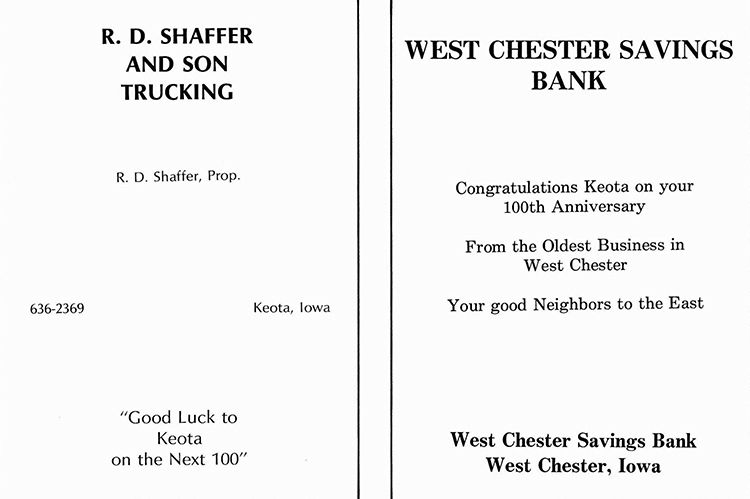
174
A glimpse into the past...
THE KEOTA INTERURBAN RAILWAY STORY
In August 1906
everything was favorable for a trolley line through Keota. Several
businessmen wrote the promoters and the answer was that they would like
to open up negotiations with the people. Many meetings were held,
surveys made, committees appointed to canvass Keota people, and
propositions made. This trolley line was to extend from Iowa City to
Ottumwa. Coming from Wellman, the line was to go through the James
Nelson farm, a part of Thomas Singmaster's, enter Keota at the north
end of Green Street via Arthur Stewart's fields, go straight through
town from north to south on Green Street, angle southwest at the park
through George Klett's farm and Lawrence Bohrofen's farm, and cross the
highway near Paul Peiffer's place. Observations with their instruments
were made and stakes driven on the entire line. The Keota people were
asked to subscribe thousands of dollars in stock and furnish right of
way for five miles in each direction from town and donate sufficient
ground for barns, etc. Unfavorable actions taken at this time killed
the interurban as far as Keota was concerned.
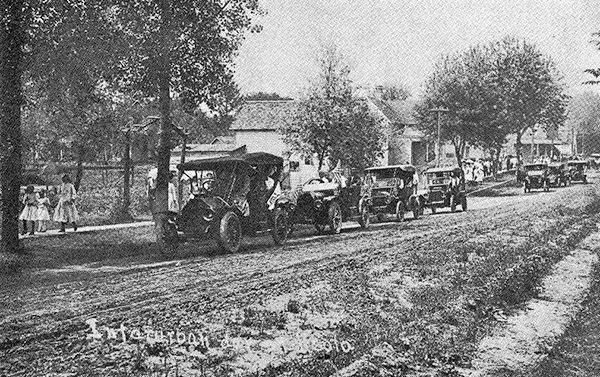
Interurban Day at Keota.

Interurban Boosters at Keota - 1910.
A VALUABLE RELIC
August 30, 1889.
There is in Keota a valuable chair, the property of Miss Sarah Buckley.
It is made of walnut wood, has a broad seat and a straight high back
with much carving. Near the center of the back are the letters J. B.
for John Buckley, great-grandfather of Miss Buckley, who brought it
over from England. Below the letters are the figures 1686 which shows
age of chair, and it has been in the family all these years. Miss
Buckley's grandfather lived on the Delaware not far from Philadelphia
in the days of the Revolution. It was from his house that G. Washington
started with his barefoot men on that march across the Delaware amid
the ice and snow. In this same chair did G. Washington, Wm. Penn and
other celebrated men sit. These facts were given the writer (Wm. Papes,
editor of Eagle) by Miss Buckley.
October 17, 1890.
Among the Keokuk Co. exhibit at the Ottumwa Coal Palace was a chair 204
years old—property of Miss S. M. Buckley of Keota, Iowa. It was handed
down by John Buckley who lived in England and the chair was brought to
this country by his son. It has supported the divine forms of
Washington, Franklin and the two Adams and a number of other "colonial
fellows." Two days later President Harrison was seated in the same
chair and said in doing so gave him more pleasure than any ot her thing
he had done at the Palace. The chair is a solid piece of furniture.
September 26,
1901. Aunt Sade Buckley's antiquated chair was sent to Sigourney and is
on exhibition at the old settlers meeting. The chair bears the date
1686 and the initials I. B. The latter means J.B. as they made a J then
as we make an I now. The following famous men have sat in the chair—Wm.
Penn, George Washington, Andrew Jackson, J. Q. Adams, and Benj.
Harrison, who occupied the chair at the Ottumwa Coal Palace in 1890.
January 20, 1910.
Sade Buckley is dead. Miss Riordan of Spokane, Washington, sent half
page write up of her and her famous G. Washington chair. Many Keota
people remember Miss Buckley and her famous chair made in England in
1686.
175
A glimpse into the
past...
WAR HISTORY
August
14, 1873.
A number of citizens met at Kulp's Hall and organized a Military
Company. Charles Hinman, J. J. Thompson and Jesse Ashby were appointed
recruiting officers.
March
11, 1882.
From Hon. H. N. Newton's Sketch of Lafayette Township. At the beginning
of the Civil War there were over 200 inhabitants in Lafayette Township.
Of these, 21 enlisted in the Army and seven of them were either killed
in battle or died of disease while in the service. The names are: Ed.
Carris, Wm. Fulton, Isaac Smith, J.D. North, Nicholas Reed, Alonzo
Hinman and Thos. Vincent. Five of these seven resided in what is now
School District No. 7. (Note: District No. 7 adjoined Keota on the
south)
G.A.R.
The
Grand Army of
the Republic (G.A.R.) was a patriotic organization consisting of
veterans of the Civil War founded during the winter of 1865-66. The
G.A.R. admitted any member of the United States Army, Navy or Marine
Corps, who had served between April 12, 1861, and April 9, 1865, and
had been honorably discharged. The organization was founded for the
commemoration of dead comrades. In 1868 the G.A.R. instituted Memorial
Day. Auxiliary orders of the GAR. are the Woman's Relief Corps (W
.R.C.) the Ladies of the G.A.R. and the Sons and Daughters of Union
Veterans.
Keota
G.A.R. Post
The
Ed Carris
G.A.R. Post No. 333 was organized here in 1884 and was chartered by the
State headquarters at Water1oo on May 17, 1884. It continued active
until the early 1920's and the State Office had it listed as ceasing to
function as of January 1, 1929. Their last record of the local post
showed I. LeRoy Pulver as Commander and J.A. Embree, Adjutant, in 1928.
Mr. Pulver had headed the post since 1918 and Mr. Embree had been
Adjutant since 1923. The last known meeting was the election of Mr.
Embree as adjutant in 1923. Mr. Pulver died in June 1928 and Mr. Embree
in June 1937. He was the last survivor of the Keota GAR.
It
is a rule that
the Charter and records be delivered to the State organization when a
local post ceases to exist. That was not done here and the State
Department was attempting to accomplish a task that had been neglected
for 16 years. Members of the Legion Post here which had the G.A.R. flag
were interviewed but no records and members of the W.R.C. whose meeting
place was that of the G.A.R. were also interviewed here in August of
1945. Charter members of the local post were the following:
Charles Hinman
William Johnson
H. C. Haney
J. O. Wallace
M. A. Crawford
John Brier
William H. Popes
B. F. Wilson |
F. M. Wilson
George Richardson
N. T. Stout
A. Stamm
G. Palmer
S. Fry
A. J. Campbell |
M. S. Russell
M. Myers
John Casford
Thomas Lantry
R. F. Campbell
George Reed
A. J . Snider |
J. B. Farris
M. S. Bishop
J. F. Graham
William Chesney
William Kreger
John Carl
Peter McDoll |
May 24, 1884. On May 17, 1884, Officer Riggin of
Wellman
was in town and completed the organization of the Grand Army of Keota
post. Twenty-five charter members were secured. It will probably be
known as Ed Carris post.
C. A. Hinman—Commander
H. C. Haney—TV Commander
John Brier—Surgeon
John Casford—Officer of the Guard
Wm. Johnson—SV Commander
M. Meyer—Officer of the Day
M.
A. Crawford—Quartermaster
September
18,
1886. Irvin Camp. Sons of Veterans was organized. There are twelve
charter members. Officers are: S. S. Sherman, Captain; E. A. Kreger,
First Lieutenant; Chas. Hinman, Second Lieutenant; G. H. Ward, Chairman
of Council; G. A. Conklin and A. L. Fry, second and third members.
Meeting nights will be first and third Saturdays of each month. Camp is
named in honor of Major Irvin, a soldier who enlisted from this county
and lost his life in the rebellion.
May
2, 1890.
Several neighbors met and surprised Mr. A. Pardun in honor of his
release from Andersonville Prison 25 years ago. Mr. Pardun was taken
prisoner at Macon, Georgia, July 29, 1864, and was put in prison August
2 and was there until April 28, 1865.
The
commander of
th e Keota G.A.R. Post in 1897 was A. Moody.
April
29, 1898.
KEOTA'S "AWKWARD SQUAD"—George Greenwood circulated a paper for the
organization of a home guard, so that in case of another call for men
Keota will stand prepared to send her quota to the front. The boys will
be drilled along regulation lines. History will redound to the fame and
glory of Keota's awkward squad.
We,
the
undersigned citizens of the United States and State of Iowa, between
ages of eighteen and forty-five years, hereby organize ourselves into a
company for the purpose of military drill and practice and pledge
ourselves to enlist as soldiers in the present Spanish-American war
when needed or called.
Forty
eight men
signed the pledge.
June
5, 1902. The
thing that impresses one more deeply with each recurring Memorial Day
is the decimating ranks of the G.A.R. A little thinner, a little
grayer, with a lower stoop, a more halting step, but still marching
bravely on.
176
A glimpse into the
past...
|
October 10, 1907. OLD SOLDIERS REUNION— Company A,
25th Iowa Infantry reunion, was entertained by comrade John M.
Wright—Oct. 8. Captain D. A. Boyer of Washington is president and W. A.
Shannon of Washington is secretary. Oldest man in Company is Uncle
Jimmy Stewart of Ainsworth who is 90 and R. Bennett, the youngest, is
60. There were stories and a bounteous dinner and supper served by the
female members of Wright family.
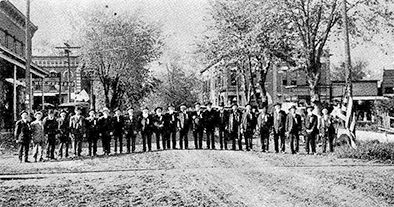
Early G. A. R. Gathering in Keota
|
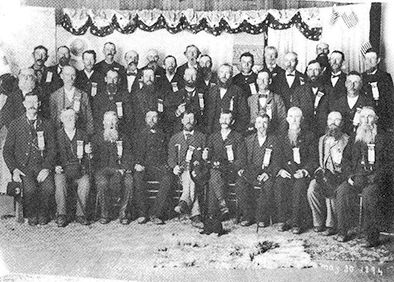
G.A.R. Ed Carris Post #303, Keota, Iowa. May 30, 1894.
Back row, left to right, Chriss Gantz, Adam Smith, I. L. Pulver, J. F.
Graham, John Ralston, John McNurlen, Wm. Nelson, Anthony Moody, Jabez
Hitchcock, Wm. Kreger, Bennie Grove, Finley M. Smock, Adam Towe,
unknown, John Wright. Middle row, left to right, Martin Bishop, Wm.
Chesney, George Divelbiss, Wm. Vincent, Seth Carris, Wm. Carris, James
R. Fitch, Andrew McCampbell, unknown. Front row, left to right, Fulton
Campbell, Walter Downing, Samuel Fry, Wm. Mitchell, David Wilson,
Jerome Wilcox, George DeYoe, Merritt Russell, Tom Pay, Samuel Calhoun.
October 24, 1912. Commander J. F. Graham of the
G.A.R. Post showed us some Confederate paper money - face value about
$180, which the war department sent to the post here as a present. The
government has a large quantity of these bills on hand since 1867 and
is getting rid of it in this manner.
May 25, 1922. G.A. R. The local post of G.A.R. has
eight members now to pay homage to their deceased comrades on
Decoration Day. They are: J. M. Wilcox, I. L. Pulver, Wm. Nelson, Adam
Smith, J. M. Embree, Mike Meyer, Adam Rowe, Seth Carris.
THE WOMEN'S RELIEF CORPS
February 28, 1885. A Ladies Relief Society has
been organized in Keota, its object to help our own poor people.
November 13, 1890. The Women's Relief Corps is an
auxiliary to th e G.A.R. All ladies 16 years and upward are eligible.
Objects of the society are to assist the G.A.R. and to perpetuate the
memory of the fallen dead, to instill lessons of patriotism and love
for our country among the children and communities in which we live.
Mrs. K. Passig of Sigourney has been authorized to institute a corps at
this place November 15, at 2 o'clock in the upper room of the
Singmaster block.
April 2, 1903. The Ladies Relief Society has
disbanded and turned its funds over to the W.R.C. The Relief Society
did a noble work and we are sorry to see it go but its mantle falls on
worthy shoulders. The Women's Relief Corps is anxious and eager to take
up the work thus laid down by the sister organization. Anyone knowing
of sickness or distress unrelieved should inform the president.
|
|

Memorial Day 1907
W. R. C. ladies and old soldiers.
|
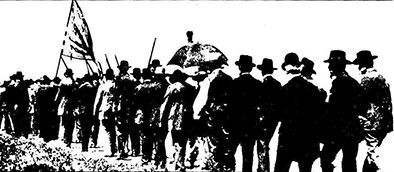
Memorial Day Parade
Some of the Boys in Blue car r ied rifles, some umbrellas, some
canes. Every year they marched to the cemetery until the last man
stood alone. |
177
A glimpse into the
past...
Mrs.
Ellen
McFarlane, and the case will receive immediate care.
December
17,
1903. W.R.C.'s is experiencing a "boom." They have taken in their 50th
member.
January
7, 1904.
The G.A.R.'s and W.R.C.'s hold a joint installation of officers. The
ladies served a big dinner at the Post Hall and all had a good time.
March
17, 1904.
The W.R.C. has outgrown its present quarters and they have asked J. S.
Stoutner who owns the building to remove the partition wall separating
the lodge room from offices occupied by Dr. Palmer, and the ladies will
now have more room.
May
25, 1905.
W.R.C. tendered a reception for Mrs. Florence McCelland of Chicago, ex
department inspector for Illinois. The lady is a sister of Mrs. W. B.
Singmaster of Dublin.
June
27, 1907.
Mrs. A. B. Singmaster has received the appointment of national aid of
the W.R.C. Corps on the staff of the national commander. This is a
great honor, and it has been conferred upon a lady who is worthy of the
position.
WOMEN
RELIEF CORPS
NUMBER 221 OF KEOTA, IOWA
The
Women Relief
Corps of Keota, Iowa, was organized December 10, 1890. The Charter was
presented the local Corps by the Department of Iowa on that date and is
still in use.
The
names that
are written on the Charter are:
Mary Smock
Mary E. McFarlane
Isabelle Wright
Fannie Moritz
Ella Tiffany
Dellie Rice
Mary Wilcox
Winnie Smock
Henrike Kriger
Nettie Eaton |
Anna Kreger
Laura Gillett
Margaret McJunkin
Emmor Campbell
May Brier
Maggie Clarahan
Nora Varner
Zoe Rust
Margaret LeydeI
Gertie Smock |
Although
all of
these names have disappeared from the community other loyal women have
carried on the work of the Corps continuously until the present time
with the present membership numbering 60.
Twenty-five
year
pins are presented with a bar for each additional five years of
continuous membership. The Corps is happy to have presented fifty years
of recognition to Mrs. Della Leinen, Mrs. Minnie Stewart of Washington,
Mrs. Maude Sanders, Mrs. Winnie Statler and Mrs. Lillie Schillig. Other
local women have belonged over 45 years.
The
Corps meets
regularly the fourth Friday of the month at the Fraternal building.
MEXICAN
BORDER TROUBLE
June
29, 1916.
The National Guards were ordered to mobilize in Des Moines. This
section of the state sent its quota of boys to help conquer Mexico—if
that has to be done. We had one member, E. G. Warrington, and before
they left Saturday morning had several more. Samuel Dings, Keith
Nevitt, Paul Fitzgerald and Clifford Gammon had enlisted and were
somewhere in the car that morning with Co. K of Washington. The ladies'
band and martial band was at the depot to see the boys off.
January
18, 1917.
They gave the soldier boys of Co. K a great welcome and turkey banquet
at Washington. They are in the National Guard and had been stationed
along the Mexican border.
March
29, 1917.
The first Iowa regiment of the National Guard was ordered mobilized for
duty Monday on short notice. The Keota members of Co. K — Warrington,
Fitzgerald and Gammon — were ordered to Washington. Their destination
is a secret.
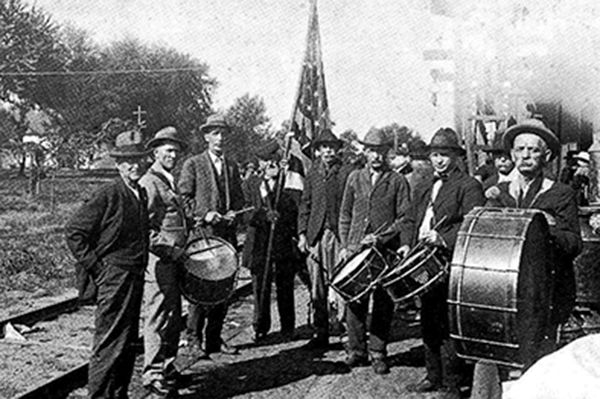
The band was at the depot to see the boys off.
Left to right, J. Wilcox,
H. Banks, C. Sturgeon, Adam Smith (with flag),
Frank Sturgeon,
Roy Pulver, Clark Pulver, Amos Schreckengast.
Harold Teets,
a member of this band, was also on his way to the Mexican border.
June 1916.
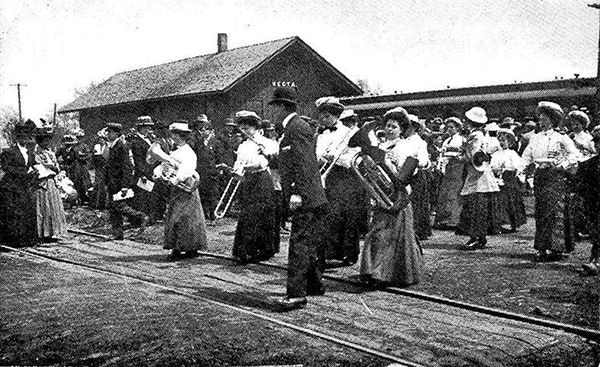
The ladies' band was at the depot also to see the boys off.
178
A glimpse into the past...
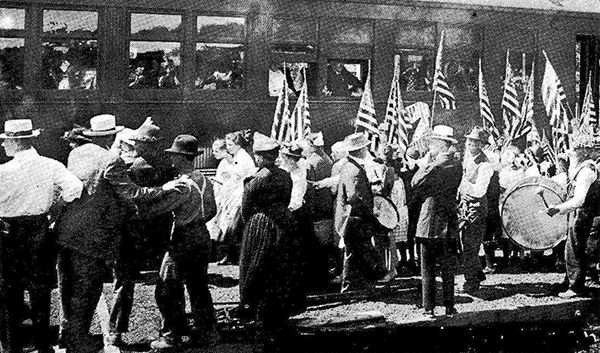
There were heavy hearts in this crowd gathered at the Rock Island
station on June 24, 1916 to see sons, brothers, husbands off to
face the dreaded uncertainties of war.
April 6, 1917. A
quartet of soldiers was here and went to Talleyrand neighborhood to see
about a report that a man was flying a German flag.
May 3, 1917. War
horses wanted in Keota Saturday, May 5—five to nine years old—no grays.
Any useful sort of horse weighing 1150 and up wanted. If you have any
horse you can spare bring them in Saturday.
May 24, 1917. The
law requires every man who passed his 21st birthday and not reached his
31st to register June 5. There are no exceptions. Exemptions for health
or other reasons will come later. Ninety-six registered in E.
Lafayette—only 33 had clean bill of health and 63 were married.
June 14, 1917.
KEOTA'S HOME GUARD.—In response to a call by Mayor McNurlen, the young
men of our community met at the Masonic Hall last evening to discuss
and organize the home guard. The mayor drew up a resolution to be
signed by those expecting to join, offering services to Uncle Sam if
necessary. Officers will be appointed by mayor in a few days and he has
arranged with Roy Menefee to act as drill master. Sixty-seven men
signed the resolution last night. The ages for enrollment are for men
between ages of 18 and 45.
$1000 a year—and
incomes of married men receiving more than $2000 a year. There are many
more taxes. The money is needed for the war efforts.
February 28,
1918. Rev. C. F. Hoffman has been appointed by Mayor McNurlen to look
after placing stars on the service flag.
May 9, 1918. East
Lafayette has purchased a total of $139,750.00 worth of third Liberty
Bonds. District of Keota gave three times its quota.
NOVEMBER
11, 1918. ARMISTICE DAY.
WORLD WAR I ENDS.
November 14,
1918. Keota celebrated Monday afternoon, November 11. A parade formed
at 2:30 at the school house under the direction of Supt. McKee. It was
about a mile long and made up of every conceivable kind of float, the
martial band and the Old Keota band, resurrected for the occasion.
Floats were mostly trucks or cars that were decorated and the parade
traveled up and down Broadway and two or three side streets. E. E.
Bower and A. C. MeNurlen made some speeches—most business firms closed
their doors.
November 14,
1918. Keota adds a Gold Star—Harry Sheets of Dutch Creek died of
pneumonia in France, October 12, 1918. He was the son of Mrs. Caroline
Sheets. He was sent to France in August. He was 24 years old.
May 19, 1921. WAR
POPPIES. Five million poppies, replicas of the red flowers "that blow
in Flanders fields," have arrived in America to be worn by Americans on
Memorial Day in commemoration of the fallen heroes of the late war.
Most of these flowers were made by French war orphans. The proceeds of
the poppy sale will go for relief work among French children in war
torn areas. The Flanders poppy has been selected as the memorial flower
because it has been said by many to represent "the soul of the dead."
It was immortalized in verse by John McCrae.
April 23, 1925.
The American Legion, the Knights of Columbus of Harper and the Keota
Chamber of Commerce have each bought a marker to represent Lafayette
Twp. boys killed in the World War. They will be placed along Jefferson
highway north and south and No. 7 east and west. Each township in the
state is asked to buy markers for its own boys. Price is $10 and
includes erection and maintenance. The K of P's also bought one.
April 21, 1932.
Keota's last Civil War veteran, William M. Nelson, son of Matthew and
Mary Dawson Nelson, was born in Washington County, March 23, 1843, and
died April 13, 1932, age 89. At 19, second year of the Civil War, he
enlisted in Company A of the 25th Iowa Infantry and served three years.
On April 9, 1868, he was married to Isabelle Vincent. Three daughters
were born to this union: Mrs. Jennie Gardenier, Mrs. Frank Pringle and
Mrs. Daisy Carris. Burial was in Keota Cemetery.
179


180
|